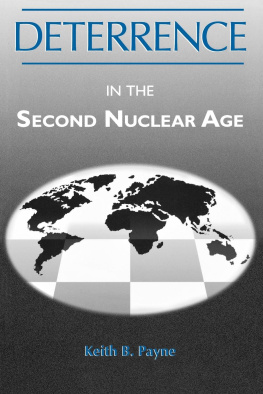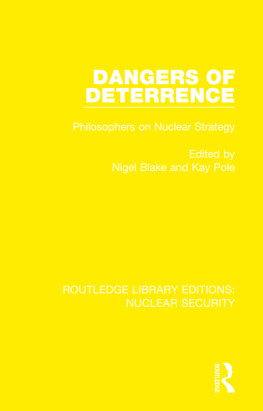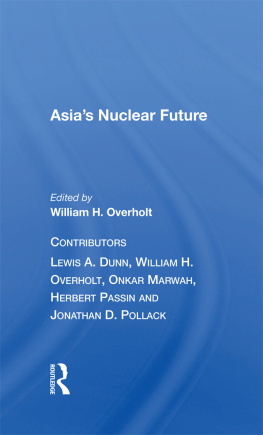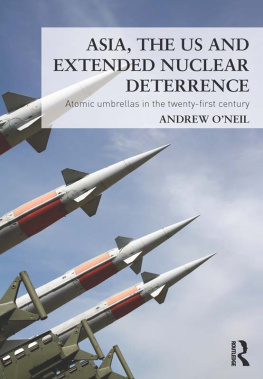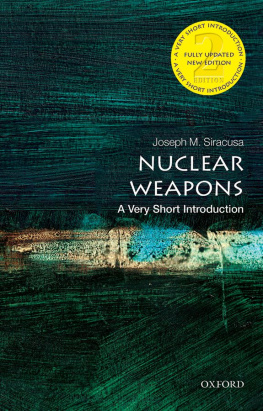
E book published by
Vij Multimedia
Vij Books India Pvt Ltd
(Publishers, Distributors & Importers)
2/19, Ansari Road, Darya Ganj
New Delhi - 110002
Phones: 91-11-43596460
Fax: 91-11-47340674
e-mail :
web: www.vijbooks.com
Copyright 2012, United Service Institution of India, New Delhi
ISBN: 978-93-81411-60-5
All rights reserved
No part of this book may be reproduced, stored in a retrieval system, transmitted or utilised in any form or by any means, electronic, mechanical, photocopying, recording or otherwise, without the prior permission of the copyright owner. Application for such permission should be addressed to the publisher.
The views expressed in the book are of the author and do not necessarily represent the views of the organization that he belongs to or of the United Service Institution of India.
Preface
This book has had a long gestation. I was fascinated about the deterrence aspect of nuclear weapons and I became more involved with this subject when I was doing my dissertation as part of Masters at Madras University in the mid 1990s. Thereafter, the events of 1999 and 2002 got me thinking about the issue in a different light. Consequently, my diverse reading has taken me to varied strands of thought and I have tried to faithfully record these as kind of bibliographic endnotes, rather than a traditional bibliography, since I thought that it may be more useful to refer it at the point of origin itself. However for the benefit of the more traditionally inclined, there a selected bibliography at the end.
This book is not about the technical aspects about nuclear weapons nor is it about the actual employment or deployment of the strategic assets. It also does not cover the various effects of a nuclear weapon nor does it discuss about the command and control aspects. It is also not about the numbers of nuclear weapons that are needed to achieve credible deterrence by each country. There are numerous authoritative books and studies dealing with these aspects of nuclear weapons and it is not my intention to duplicate those. Suffice to reiterate that it is been established scientifically and beyond reasonable doubt that a nuclear war would be catastrophic and bring with it colossal damage to human lives, property and lasting misery. This study is more about the fundamental nature of nuclear weapons and as to how the nations of Asia view these weapons. It is also about the nature of disputes in Asia and the security environment in Asia, both presently as well as in the foreseeable future. Since it is a fact that there are unresolved disputes in the region, it is important to attempt an analysis of potential conflict scenarios. Will the countries succeed in settling their disputes diplomatically? Can deterrence succeed? What will happen if that fails? What will be the shape of future conflicts? I have tried to approach this from an Indian perspective. Do the nuclear powers of Asia view nuclear weapons in the manner that we Indians do, namely, for deterrence against nuclear weapons only? Will these nations use them as weapons of war fighting? If so, what will be the likely provocation for deterrence breakdown? These are the questions which this book attempts to answer.
During the Cold War, driven by the most primitive impulse of each state for its security, the emergence of nuclear weapons was thought to put an end to war and ensure world peace through its deterrence effect. However, nuclear weapons in the possession of a few has actually resulted in a security dilemma in which all states aspire to possess nuclear weapons but face acute security issues all the time. This has resulted in making the world more insecure and unstable since the number of nations that aspire to become nuclear weapon states has actually increased. Nuclear weapons are perceived to be safe in certain hands and extremely dangerous in the hands of some other states. This has not only forced the world to rethink about the relevance of nuclear deterrence but also to an increased scrutiny of the relevance of nuclear weapons itself. The most intense scrutiny is in Asia. While many have attributed the relative strategic stability between the US and the erstwhile USSR to nuclear weapons, it is also undeniable that it has failed miserably to deal with certain facets of asymmetrical warfare. 9/11 has changed the way that the world looks at security. Suddenly, terrorism has literally entered the living rooms and the bedrooms of all nations; western countries included. In the face of such an indefinable enemy, the efficacy of conventional force and the nuclear option appears redundant. This is not to state that nuclear weapons have lost their relevance. Nuclear weapons are still very relevant and nuclear deterrence has been successful in deterring conflicts not only between the USA and the former Soviet Union during the Cold War period but has also been successful in deterring conflicts in Asia. For instance, it is widely believed that the nuclear factor has been largely responsible in preventing any open Indo-Pak conflict since 1971.
It is oft said and is also widely believed that the 21st century belongs to Asia and that the two giants of Asia, namely, China and India are going to dominate the world in the ensuing decades. The worlds sole super power, the USA continues to engage actively in Asia. With the presence of so many players, the region is bound to witness historic events, whether these are of intense rivalries or unprecedented partnerships or an uneasy co-existence is as yet unknown. It is also important to analyze whether the future is going to be a repeat of the past history of strife and conflict or has the world learnt from its past mistakes and is now genuinely pursuing conflict prevention processes? While conflict transformation and reconciliation between historic rivals maybe a bit unrealistic in the near time frame, at the very least, will conflict prevention efforts succeed in preventing the outbreak of armed conflict? What, if any, are the scenarios that could possibly result in a conflict in Asia?
Emerging from the chrysalis of its Cold War geopolitical confinement in the South Asian region, India has actively sought to engage purposefully with major powers and emerging power centers, as well as with countries in its immediate and extended neighborhoods. The import and significance of the former Indian Foreign Secretary Shyam Sarans November 2006 speech in China at the Shanghai Institute of International Studies is worth noting. Asserting that Indias destiny is interlinked with that of Asia, Saran assertively underscored the premises underlying this new vision:
Geography imparts a unique position to India in the geopolitics of the Asian continent, with our footprint reaching well beyond South Asia and our interests straddling across different sub-categories of Asia be it North East Asia, West Asia, Central Asia, South Asia, or South East Asia. To those who harbour any skepticism about this fact, it would suffice to remind that India shares one of the longest borders in the world with China, that Central Asia verges on Indias northern frontiers, that the country has maritime borders with three South East Asian countries, that Andaman and Nicobar Islands are just over a hundred kilometers from Indonesia, and that the Indian exclusive economic zone spans the waters from the Persian Gulf to the Straits of Malacca.
This book examines the manner in which nuclearised Asia is shaping and particularly the potential conflict zones in Asia and the possible nuclear flash points. Since the study is from an Indian perspective, the focus is naturally biased more towards South Asia vis--vis the other parts of Asia. In the study, South Asia includes the region from Afghanistan in the West to Myanmar in the East, and from China Southwards. Today, the region cannot be seen in isolation and hence, influences of West Asia as well as North East Asia need to be factored in, as well as the role of the US.




